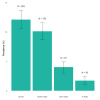Prevalence of Doravirine Resistance Mutations in a Large-Scale HIV-1 Transmitted Drug Resistance Survey in Buenos Aires, Argentina
- PMID: 40431742
- PMCID: PMC12116006
- DOI: 10.3390/v17050731
Prevalence of Doravirine Resistance Mutations in a Large-Scale HIV-1 Transmitted Drug Resistance Survey in Buenos Aires, Argentina
Abstract
Background: Argentina has reported moderate to high levels of transmitted drug resistance in people living with HIV/AIDS (PLWHA), mostly to non-nucleoside reverse transcriptase inhibitors (NNRTIs). Doravirine (DOR) has a unique resistance profile and retains potent antiviral activity in the presence of the most prevalent NNRTI-associated resistant viruses. Scarce data exist regarding the frequency of DOR resistance-associated mutations (RAMs) in Latin America. We describe the prevalence of DOR RAMs in samples from adults PLWHA in Buenos Aires, Argentina, in the context of a survey of transmitted drug resistance (TDR).
Material and methods: A cross-sectional study was undertaken utilizing samples collected between 2017 and 2021 at two reference HIV clinics. Samples were analyzed for RAMs using the World Health Organization (WHO) mutation list. Mutations to DOR were assessed with the Stanford and Agence Nationale de Recherches sur le SIDA (ANRS) algorithms. Rilpivirine (RPV) RAMs were assessed using the Stanford algorithm. Susceptibility to NNRTIs was evaluated using the HIVdb Program with Stanford and ANRS criteria.
Results: Samples from 1667 PLWHA were analyzed: 81.2% were male, with 52.6% identifying as men who have sex with men. According to the WHO list, the overall TDR was 12.1% (n = 203). The prevalence of RAMs was 10.1% (170/1667) for NNRTIs, 4% (67/1667) for nucleoside reverse-transcriptase inhibitors (NRTIs), and 1.7% (30/1667) for protease inhibitors (PIs). The most frequent NNRTI mutations were K103N (5.6%), G190A (0.89%), and K103S (0.77%). The prevalence of DOR RAMs was <2%, with the most common being Y188L (0.53%). Rilpivirine RAM prevalence was 6%. Susceptibility to DOR, RPV, efavirenz, and nevirapine as given by the Stanford algorithm was 97.4%, 92%, 91.4%, and 90.4%, respectively. The ANRS criteria yielded susceptibility rates of 98.3%, 93.3%, 92.3%, and 90.8%, respectively. Regarding NRTIs, thymidine analog mutations (including T215 revertants) were the most frequent RAMs. Among PIs, the most prevalent RAMs were M46L (0.47%) and V82A (0.35%).
Conclusions: Our study shows the persistence of moderate to high levels of resistance to first-generation NNRTIs. Despite this, prevalence was low for DOR. Surveillance of TDR remains critical for recommendations of ART initiation.
Keywords: HIV; Latin America; antiretroviral agents; doravirine; mutations; prevalence; resistance.
Conflict of interest statement
D.C. received speaker’s fees and travel grants from MSD; I.C. received speaker’s fees and travel grants from MSD; G.L. received fees for advisory boards from MSD. G.B., M.T., and E.B. are MSD full-time employees. All other authors declare that they have no known competing financial interests or personal relationships that could have appeared to influence the work reported in this paper. These financial relationships are hereby disclosed in the interest of full transparency. The authors affirm that these arrangements have not influenced the content or conclusions of the present work.
Figures


References
-
- Gandhi R.T., Bedimo R., Hoy J.F., Landovitz R.J., Smith D.M., Eaton E.F., Lehmann C., Springer S.A., Sax P.E., Thompson M.A., et al. Antiretroviral Drugs for Treatment and Prevention of HIV Infection in Adults: 2022 Recommendations of the International Antiviral Society-USA Panel. JAMA. 2023;329:63–84. doi: 10.1001/jama.2022.22246. - DOI - PubMed
-
- UNAIDS. [(accessed on 29 April 2025)]. Available online: https://www.unaids.org/en/resources/fact-sheet.
-
- World Health Organization. [(accessed on 29 April 2025)]. Available online: https://www.who.int/data/gho/data/themes/hiv-aids.
Publication types
MeSH terms
Substances
Grants and funding
LinkOut - more resources
Full Text Sources
Medical

